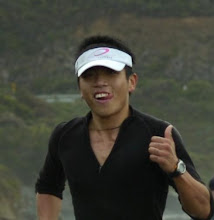Thursday, June 15, 2006
I have come to this conclusion: there IS a difference between marshalled and non-marshalled AR courses. The difference is this: one favours the power athlete, the other the thinking athlete. A power athlete and a thinking athlete can be one and the same thing, but without sound tactics, or more importantly, experience in the field, everything goes to hell. I don't know which kind of athlete you would consider yourself to be, but remember this: the ability to go fast simply translates into the ability to go fast in the wrong direction.
Once more, i resume my tirade on the changing nature of our sport. If you are a power athlete, stick to multisport and triathlon. If you want a real challenge that actually harnesses the ability of the brain to think during a race, go adventure racing.
A key goal of mine is to learn from the best in the field of literally 'thinking on one's feet' - the rogainers and orienteers of Australia. Adventure racing navigationconcists of skill sets that that need to be developed further along the lines of navigation during military operations - something that a good number of Singaporean males are exposed to, but sadly never developed beyond their service duration. The beauty of adventure racing is the GREAT potential for navigation to make or break a team's race effort. At the top level of the sport, the elite teams have at least one first-class navigator in their squad. I don't know how to put it, but the so-called best teams in Asia have yet to prove their ability on a course with a heavy emphasis on navigation. The comments of Keith Noyes on enduranceradio.com summed it up: "The standard of navigation in Asia is not very high"... his reason for including only orienteering 'sections' in his races (with the rest of the course marked and guided), rather than committing the entire course to navigation.
Those were fair comments, though they pissed me off to no small degree. Here is one expatriate who has a keen grasp of the mindset of the typical Asian adventure athlete - go hard, brain switched off. To have the brain switched ON at all times should be the way top performances are created.
The most satisfying race i have ever done would not be XPD, as many would imagine. It would be the Kathmandu Max Adventure Sprint in Lysterfield Park last November. That was one race where there was definite navigation going on, and for the first time ever, i was put in charge of sorting out the route planning. A close second would be the Red Yeti, also in November. It was my first insight into overnight racing and CP to CP navigation.
Somehow, i don't think the mass appeal of events like Action Asia or Ace Adventure would appeal to me any more if i could help it. Putting two races side by side, i would go for the race with more demanding navigation any day. The reason: I don't bother going fast unless it is in the right direction.
Once more, i resume my tirade on the changing nature of our sport. If you are a power athlete, stick to multisport and triathlon. If you want a real challenge that actually harnesses the ability of the brain to think during a race, go adventure racing.
A key goal of mine is to learn from the best in the field of literally 'thinking on one's feet' - the rogainers and orienteers of Australia. Adventure racing navigationconcists of skill sets that that need to be developed further along the lines of navigation during military operations - something that a good number of Singaporean males are exposed to, but sadly never developed beyond their service duration. The beauty of adventure racing is the GREAT potential for navigation to make or break a team's race effort. At the top level of the sport, the elite teams have at least one first-class navigator in their squad. I don't know how to put it, but the so-called best teams in Asia have yet to prove their ability on a course with a heavy emphasis on navigation. The comments of Keith Noyes on enduranceradio.com summed it up: "The standard of navigation in Asia is not very high"... his reason for including only orienteering 'sections' in his races (with the rest of the course marked and guided), rather than committing the entire course to navigation.
Those were fair comments, though they pissed me off to no small degree. Here is one expatriate who has a keen grasp of the mindset of the typical Asian adventure athlete - go hard, brain switched off. To have the brain switched ON at all times should be the way top performances are created.
The most satisfying race i have ever done would not be XPD, as many would imagine. It would be the Kathmandu Max Adventure Sprint in Lysterfield Park last November. That was one race where there was definite navigation going on, and for the first time ever, i was put in charge of sorting out the route planning. A close second would be the Red Yeti, also in November. It was my first insight into overnight racing and CP to CP navigation.
Somehow, i don't think the mass appeal of events like Action Asia or Ace Adventure would appeal to me any more if i could help it. Putting two races side by side, i would go for the race with more demanding navigation any day. The reason: I don't bother going fast unless it is in the right direction.

